
 |
Ludham
Businesses in the 20th Century
|
LUDHAM
BUSINESSES 1900-2000
Research – Yvonne Boldy with Wendy Chapman and Marion Roll
Text – Nigel Pope
Ludham began the 20th Century with its economy firmly rooted in agriculture. Surrounded by rich farmland and productive marshes, the village was sustained by the income generated by the various farms and the employment they created.
Many other businesses operated in the village to provide services to the local population, and this page is about their history.
It would be impossible (and probably not very interesting) to list all the businesses that have ever existed in Ludham over the past one hundred years. This page concentrates on the larger and more visible businesses and tells their story as the century unfolded.
1900 to the Great War.
Many Ludham residents began the century as agricultural labourers. These days were long before the mechanisation of farming and farming methods had seen little change for centuries. Many workers were employed on a casual basis as seasonal needs dictated. It could be a hard life.
Ludham itself would have seemed quite a remote place in those days. The village was surrounded by rivers and marshes and had no railway station. The motor car had just been invented, but it is doubtful that Ludham had ever seen one. Heavy goods were transported by water in the sailing wherries which visited Womack Water and Ludham Bridge. A visit to Norwich was an all day journey by cart and the railway stations at Potter Heigham and Hoveton/Wroxham called for a long walk.
As a result, there was a need to buy everyday items locally and various shops and businesses were set up in the village to meet local needs.

A trading wherry at Ludham Bridge
On the corner of School Road and The Street stands a building which is still known locally as Cooks Corner (after the owners in the 1920s). This building, believed to be the oldest dwelling house in the village, was originally Town Farm and was owned by Aaron Neave. In 1908, Robert Allard opened a Cycle Agency here. It later became a grocery shop operated by Harriet England (perhaps as a result of competition from H.D. Brooks’ cycle shop which was just across the road). This change established a grocery and general store in this building which would endure for the next 80 years.
H.D. Brooks had already established his cycle shop on The Street in the early 1900s. He operated from a small building (still there) in which he did cycle sales and repairs as well as shoemaking. The shoemaker business was later taken over by Mr Clarke and H.D. Brooks moved his business further up the road to Catfield Road and ran his business from a wooden roadside shed in the grounds of what is now Folly House (known then as Shrublands). The business was successful and two petrol pumps were later added as the business expanded into a garage to cater for the needs of the motor car.

Looking round the Ludham area today, the ruins of many windmills can be seen, just a fraction of those which once stood in the area. At the start of the 20th Century, these mills were vital parts of the local economy, grinding corn, but more importantly driving the pumps which drained the marshes. Many of these mills were designed and built by Englands Millwrights. The offices and workshops of Edwin England stood on The Street in 1900 where the garage forecourt is today.
Englands were a well established and respected business building, improving and maintaining mills over a wide area. This old Ludham family had been in the mill business for generations and were an important local employer. This time was the peak of their success as a business. Daniel England was the inventor of “The Patent Turbine for Fen Drainage”, an important device in the wetlands round Ludham. A book about the England family is currently being researched and should make fascinating reading when produced.
On the opposite side of The Street from Englands, on the site of what is now Thrower’s Car Park, stood the butchers shop of William England, Butcher and Slaughterer. The names William and Daniel appear in every generation of the England family. A fine family tradition if somewhat confusing for historians. In those days, the slaughterman would visit local farms and would then the meat products would be sold locally. This site continued as a butchers shop for the next 65 years.
Next door to the butchers, A. T. Thrower opened a new grocery shop in 1902. He was told by his competitors in the village that this new enterprise would not last a year and there was good reason to suppose this would be true as two previous businesses had not lasted 6 months in the shop. However, the business prospered and in 2002 celebrated the centenary of the business still operating in the Thrower family. It was a more modest affair back then with a shop and local delivery service.
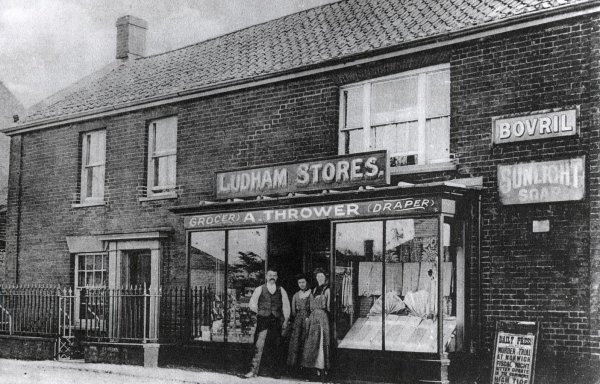
Opposite Throwers was a general store operated by Harriet Bond. This shop is still there and is now a florist.
Next door to Throwers on the other side from the butcher stood The Baker’s Arms. This beer house had been operating since 1842 and sold Bullards Ales and Stouts. In 1900 the landlord was John Davey. The Bakers Arms also had rooms to let which would have been used by travelling salesmen and other visitors to the village.
The Baker’s Arms sold only beer and had no pumps. The landlord had to go down into the cellar every time a pint was ordered and he was sometimes a bit reluctant to go down just for one drink preferring to wait until several had been ordered. This pub also incorporated a bakehouse where local people could bring food to be cooked in the oven. This building is no longer present having been demolished in 1959. The place where it stood is still known as Bakers Arms Green.
Opposite The Bakers Arms is the King’s Arms pub. The King’s Arms was known to be open in 1836 and is still operating as a pub and restaurant today. The present building is little changed from the one which would have been familiar to Ludham people in the 1900s. Daniel Chasteney England was the landlord from 1883 starting an association with the England family which would last until 1922. Edwin William Daniel England took over as landlord in 1900 and this must have been in addition to his duties at Englands Millwrights next door.
At the end of The Street near to St Catherine’s Church stands Crown House. This old building had many uses in the 20th century, but as the century began, it was the Rose and Crown Pub (sometimes just known as the Crown). The pub had been established for a long time and there is a record of it in 1752. In 1900, Eldred Slaughter was succeeded by Sarah Slaughter as landlord. Shortly after this, the pub closed down.
In 1907, Ebeneezer Newton established his business in the old Rose and Crown premises. Ebeneezer was a Miller and Corn Merchant as well as a Carrier and Shipping Agent. Supplies arrived by wherry to Womack Staithe or by train to Potter Heigham. The shipping agent business was for emigration and you could arrange here to start a new life.
Next door in what is now the Butcher’s shop was the Grocery and Drapery shop owned by Grace Lyon from 1904.
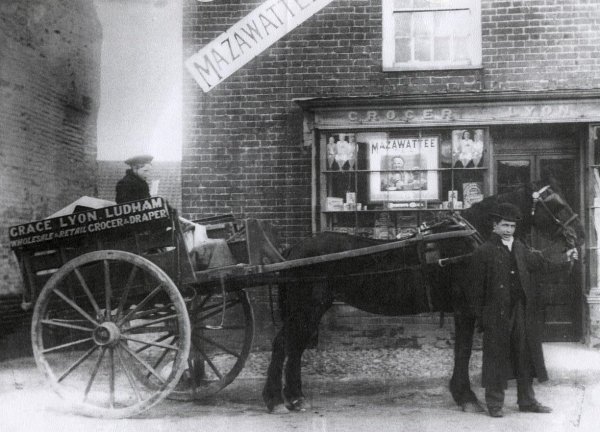
The village Post Office was located next to the entrance gates to the churchyard. In 1908, J. W. Dale was the post master. The post office had been previously located in Crown House and also in a thatched cottage opposite the church in Norwich Road. However, the shop next to the church gates was to be its home for the next 80 years. The building is still there and is known as the Old Post Office.
In the early 1900s, Staithe House in Staithe Road was the wherry harbour where supplies for the village were unloaded with warehousing for storage. In 1918, Dr Brown, General Practitioner opened his surgery there starting an associating with medical services in this part of the village which still continues. Prior to this, the village doctor called on people in their own homes (if they could afford it). The surgery facilities were very basic and there was no waiting room. Patients simply queued out in the street waiting their turn.
On the other side of Womack Water was Womack Staithe in Horsefen Road. Here stood the maltings, a large storehouse and next door were kilns for brick making using materials quarried near to the site.
Next door to the King’s Arms in Norwich Road stood the shop and premises of Samuel Knights, Harness maker and Saddler. This shop is still there and is now a tea room. Horse power was very important to the farming industry and this shop provided essential services. Next door and to the rear of the cottages were the workshops of the blacksmith, Percy Salmon and Carpenter/Wheelwright Len Bush. There was even a useful stone outside to help you get back on your horse. This stone (actually an erratic left by a glacier in the last ice age) can still be seen.
Next to this was The Limes cottage (still there). In the outbuildings of this cottage, Fred Thrower, Coal Merchant and Pig Farmer had his business.
At the rear of Glenhaven cottage on Norwich Road was a smokehouse for fish and Eldred Slaughter, Fish Dealer (and Rose and Crown landlord) had his premises at No1 Alma Cottages.
Near to Ludham Bridge is the small hamlet of Johnson Street. Here stands the Dog Inn a freehouse which has been a pub for many years. There is a reference to a building on this site called Dog House in 1689 and the pub was known to have been operating in the 1820s. In 1900, the landlord was Thomas Smith. The Dog is now a freehouse, but it used to be a Stewart and Pattersons public house.

That was how Ludham looked in the early 20th century. A farming community with local businesses providing essential services. Plenty of pubs, an important millwright’s business and shops to meet your every need with plenty of competition. There were small businesses too, builders, chimney sweeps, carpenters and many more on a small scale. A self contained place, but with the First World War, the pace of change was gathering.
Between the Wars
Ludham lost is fair share of men to the Great War and at the end of hostilities, former servicemen began to arrive back in the area. As part of a government scheme, some were allocated allotments or smallholdings in the village others returned to former work in farming, but there were changes happening on a wider scale.
Motor transport arrived in the village in the form or a regular bus service and a bus terminus was created next to the Kings Arms. Here buses were parked overnight while drivers lodged at the Kings Arms. Motor cars too became much more commonplace although the roads were still narrow and slow. Ludham lost a lot of the isolation it once had.

The Kings Arms with the entrance to the bowling green on the right
In 1926, electricity arrived in Ludham and was available for connection to homes. Percy Turner’s mother fell through the ceiling when the electric wiring being fitted to the Kings Arms
Diesel pumps began to have an impact on the mill industry and Englands Millwrights began a decline which would see them close by the Second World War.
The Norfolk Broads themselves also began to change and the process of replacing commercial boats with holiday packages began. Womack Water was a popular place for holiday makers to visit, and they began to use Ludham shops and provide a boost to business.
The 1930s brought the depression and a general slow down to which Ludham was not immune. However, Ludham businesses continued to operate and adapt to changing times.
In the 1920s, Gladys and Herbert Cook took over the shop on the corner of School Road which is still known by their name. They ran a grocers and general stores helped by their two sons Humphrey and Donald. This continued until the 1950s when Mrs Cook died.
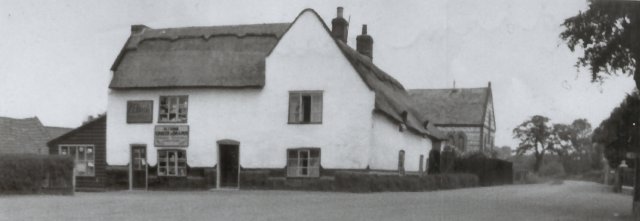
Cooks Shop 1930s
H. D. Brooks moved his growing garage business to new premises in The Street. This is the site of the present Kings Arms car park and it had the Eastern Counties bus park behind it.
England’s butchers and A. T. Thrower’s stores continued to operate and grow as did the pubs and this part of The Street must have seemed changeless. A. T. Thrower also took over in the 1940s, the shop opposite which had been run by Harriet Bond. This now became a china and hardware shop selling a wide variety of goods including linoleum, gardening equipment, nails and tools.
In 1922 the Powell family took over from Grace Lyon operating the shop as a grocery. This continued until 1942 when a bullet from a German aircraft killed Mrs Powell as she sat at the dining table in the living accommodation behind the shop. The bullet marks can still be seen in the shop walls if you look carefully.
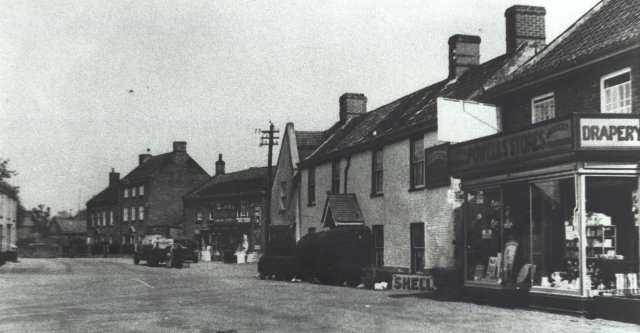
Powell's shop with Crown House beyond it.
In 1923, George Thrower took over as post master, and with his wife Helen ran the shop as a post office and general store. This family association continued after George’s death in the 1960s, and Helen finally gave up running the shop in 1989 at the age of 92.

The King’s Arms Pub continued to be an important part of village life. The area where the restaurant is presently located was known in the 1930s as the Green Room, a good place for youngsters unless they were caught by the policeman who sometimes stopped in the pub for a drink. Where the present children’s play area now is, there used to be a bowling green. The King’s Arms had a large bowling team at this time. The green was located behind the garage along with a small car park and rubbish dump for the pub.
In Staithe Road, opposite the Manor Gates was a small community bake house (people often did not have oven facilities at home). In 1925, Liza Clarke opened a sweetshop here. This building is still there although reduced in size.
In the 1930s, Mrs Grimes opened a new tea rooms and confectioners shop on the corner opposite the Kings Arms.
In 1937, Albert Knights, son of Samuel took over the Harness makers and saddlers shop in Norwich Road from his father.
The small bungalow next to the Village Hall in Norwich Road was opened as a fish and chip shop in the 1930 by Mr Mulley. This continued into the 1940s and this building is still there as a private house.
In the hamlet of Fritton were the workshops of Cyril Bensley. Here he kept his threshing machines which were used at harvest time on the local farms. Cyril had three complete sets including steam engines (later replaced by diesel).

The 1920s saw the opening of a new shop at Ludham Bridge, called Ludham Bridge Stores. The shop was started by Mrs Grounds in a spare bedroom at her Bridge Cottage home. Her husband then built a wooden shop in the garden which was subsequently moved to the riverbank. The business moved to its present day location across the road in the 1930s.
In the 1920s, Ernie Anderson opened a blacksmiths business in School Road. Next door was Fred Riches, a Carpenter. The building, almost opposite the school is still in use today as a boat engineering business.
The Second World War had a major impact on Ludham Village. An army camp was set up in the village and a airfield was built. This brought a large influx of people into the village and pubs and shops saw a new source of customers. Beulah Gowing (Turner)was the daughter of the Kings Arms Landlord, Percy Turner. She recalls that locals were rather suspicious of these incomers drinking all their beer. However, the pub was a lively place with a happy atmosphere even when the beer ran out.
The death of Mrs Powell from a German bullet in 1942 (see above) was closely followed by that of her husband. The Powell daughters were too young to take over the business and so the Smith family took over the running of the grocers shop.
Mrs Brooks from Ludham Manor was now the owner of the butchers shop in the Street having taken over from the Englands.
A. T. Throwers and the butchers next door had a miraculous escape from destruction when an aircraft crashed into the opening between them. Russell Brooks and Cyril Thrower were amongst those who rescued the pilot from the burning wreckage and received commendations for bravery .
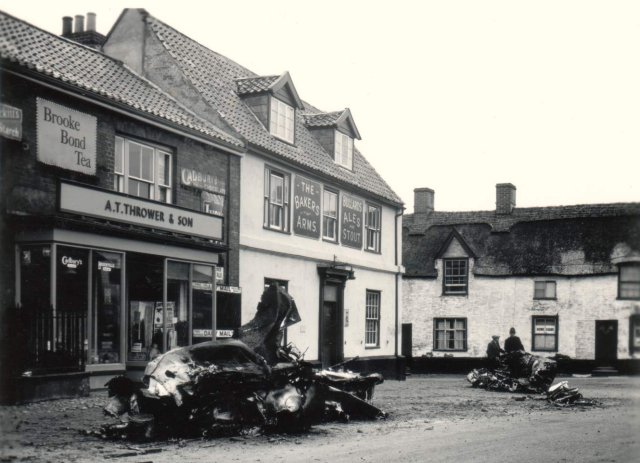
Plane crash outside Throwers also showing the Baker's Arms
Post War Growth and Change
Ludham businesses had an air of permanence between the wars, but the period immediately after the war saw a lot of changes. Britain was at the point of economic collapse after the war and it was essential to build up new businesses and industry. Ludham responded to this with a wave of new businesses and changes to the old ones.
New houses were built replacing the old army camp and the process of agricultural mechanisation began, resulting in the loss of many traditional farming jobs.
The post war austerity gradually gave way to rising affluence and greater mobility with improved bus services and car ownership. Holiday makers began to come to the Norfolk Broads in increasing numbers and the use of trading wherries on the waterways died out altogether. There was no further need for windmills and pumps, and most fell into disrepair. England’s millwright business had ceased trading and the workshops were demolished.
Gladys and Herbert Cook were still trading in their shop on the corner of School Road. This continued until the death of Mrs Cook in the 1950s. The shop then had a series of owners over the next 30 years.
Their son Humphrey was first. He married Lilia Moll after his first wife died. The shop continued trading under the ownership of the Lithgows, Gibbs and Betty Warren. Betty opened “Aarons Nook” a tea room which was accessed by a difficult climb up narrow stairs. This was a fairly short lived venture, and the shop was sold to Betty and Ernie Taylor before it was finally converted into 3 private dwellings by the Sedgewicks. In the early 1960s, there was a large fire at the shop which burned down all the outbuildings (former cart sheds and stables) where the shop stores were kept.

Cook's Shop
The small shop on The Street which had once housed H. D. Brooks’ cycle shop and later Clark’s shoemakers began a whole string of different uses after the war (when it had been a waste paper store). In the 1950s it was Mc Bride’s cobblers. Then in the 1960s it became Gale’s Barbers shop and then Robert’s Hairdressers. By the 1970s, it had become Sun Boats, a boat agency and then reverted back to a cycle shop run by the Sparrows.
Ludham Garage moved to its present location in The Street replacing the former England’s workshops and a wooden house next door which belonged to another Mr England. This section became the current garage forecourt and the round ball from the dividing wall can still be seen today as a last reminder of the former use of this part of the site. In the 1950s, Alex Snelling took over the ownership of the business followed by Mr Littleworth and then the present owner Arthur Clarke in the 1960s. The new premises allowed this business to expand with large workshops and car sales as well as forecourt services.
The wooden shop at Folly house which had been the former site of the garage was sold to a well known actor, William Mervyn. He demolished the shop and built a flat over the garages.
Edward (Ted) Hall took over as the butcher in the 1950s. He died in 1956 and was succeeded in 1957 by Sydney Sexton (also owner of Fines of Horstead). In 1958, A.J. Gower took over the business and it continued to trade under this name. In 1964/5, this shop was demolished to make way for an extension to Thrower’s supermarket and the butchers business moved further down The Street into the shop which had been the Powell's store.
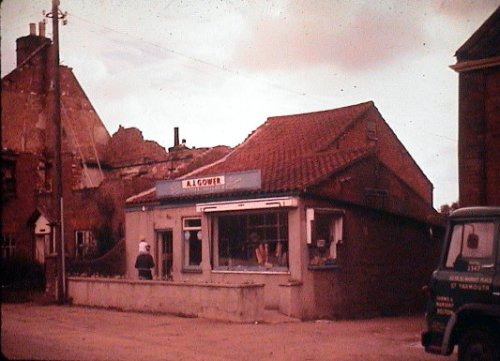
In 1956, Cyril Thrower and his wife Lillian took over Throwers shop from his father. The business continued to grow and in 1965 was considerably expanded when the supermarket was created by extending the shop onto the site formerly occupied by the butchers and by purchasing the former 3 story house next door which had been destroyed by fire.. This shop gradually became the dominant supplier of groceries in the village and the other shops began to decline and change to other uses. In 1970 a hairdressers was opened above the shop and in 1989, the village post office moved inside Throwers. Throwers gave up the china shop opposite and in the 1980s, this became a Fax and Copier service (a real sign of changing times).
The Kings Arms pub continued to prosper and was able to extend into the area which had been the bus park and H. D. Brooks Garage. The Baker’s Arms opposite, was not so fortunate. It was in decline and in 1959 it was demolished as part of a road widening scheme. The grass area near the present bus shelter is called Bakers Arms Green after the pub which once stood there. The road widening scheme was long overdue and removed the major bottleneck in the middle of the village along the Yarmouth and Norwich Roads. The last landlord of the Baker’s arms was Harry Warren. Harry had a hair cutting sideline to his pub business and this was located in the stables and outbuildings behind the pub. It cost 6 old pence to have your hair cut. Harry also charged accumulators to run wireless sets. This service also cost 6 old pence.
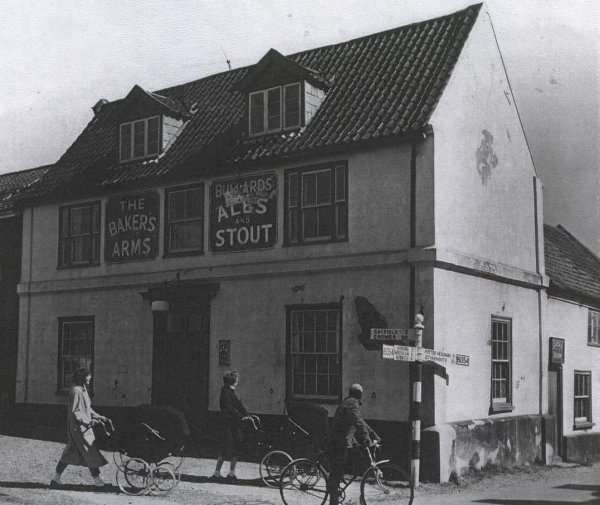
The corner shop opposite the Kings Arms had started as a tea room and was taken over in the 1940s by Colonel Taylor a solicitor.. It changed hands again in 1954 and became a confectioner, cigarette and post card gift shop catering for the increasing tourist trade. At first Pam Hales ran the business. It changed its name in 1961 to Barnard Stores and in 1964 Pat Lambert took over. In 1965 Babs Hall ran it as a gift shop and crafts followed in 1988 by Ann Sparrow. Babs introduced the name “The Corner Cabin”.
At Crown House, Ebeneezer Newton died in the 1940s and Eddie and Arthur Newton continued to run the business as a Corn and Coal Merchants. In 1945 Wilfred and Kathleen Brown (nee Newton) took over as agents for Bessie and Palmer’s Coal Merchants. The building also housed a branch of Barclays Bank open on Thursday mornings only during the 1970s. Anne Newton Sparrow (nee Brown) took over in 1979. Behind the house were stables and lean to sheds for animals. There was also a well and a store and weighing room for the corn. The house had a big cellar for storing the beer barrels in it’s pub days and if you walked in at the back, there was still a row of coat pegs which were used by the pub customers.
Next door, the Smiths continued to operate their grocers shop. They were succeeded by the Hudsons in 1950 and in 1958, the Knights transformed the shop into a Dairy and Café. In 1962, Mr Howe took over the café and in 1964 A. J. Gower butchers moved into the shop from their former premises further up The Street. This shop continued trading as A. J. Gowers with Rodney Wright running the business and the living accommodation where Mrs Powell was killed was converted into 2 flats.
During the war and into the 1950s, Harry Grapes had a Fish and Chip Shop at Nos 3 and 4 The Street which is opposite the Old Post Office. Harry also made and sold wooden toys which were much in demand during the war (as were his chips). In the 1970s, this became Cramb’s Drug Store and then Patricia’s Cake Shop and Norma Sayce’s Cake Shop. These are now private houses.
In the 1940s, the former bake house opposite the Manor Gates in Staithe Road was another Fish and Chip Shop (Abels). It also sold milk and was a children’s clinic supplying fruit juices which were considered to be a necessary supplement for children at that time.
The Post Office was still being run by Helen Thrower (see above).
Ludham Manor was owned from the 1930s by Mrs Armitage (who later remarried and became Mrs Brooks). Before the war, the Manor had a “Bird Sanctuary” in the garden and still had some caged birds after this time. In the post war period it also had The Fairy Garden in the grounds. It was possible to walk through the Manor grounds and see various “fairy” houses, wishing wells and other displays. There was a tea room and gift shop.
Mrs Brooks drove about in a polished black van with a liveried chauffeur. She always wore a shawl on these occasions.
Mrs Brooks left the Manor to Dr Gabriel in the 1970s. Some small craft industries moved in for a while including a violin maker and a sculptor, also Mr Elphick (restorer), A. Read (upholsterer) and R. Bacon (furniture maker).
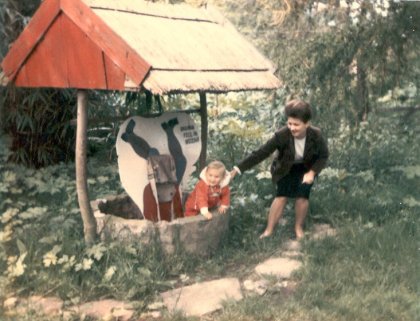
A well at the Fairy Garden
Full list of doctors in the Ludham Practice:
The Manor
1879-1918 James Alexander Gordon LRCP LRCS (Edin) LM
Staithe House then new surgery from 1977.
1918-1947 Evelyn Kempson Brown MRCS LRCP
1947-1964 Peter Remington Wilson MA MRCGP MRCS LRCP
1955-1959 Geoffrey Leon Bolt VRD MB BS FRCP (Assistant 1953-54)
1959-1982 David Wilson Gabriel MB BS MRCGP
1962 Leo House Surgery built, Stalham Green
1965-1997 Duncan Alexander Edmonds MB BS D(Obst)RCOG
1971-2002 Robert James Terry Jarvis MB ChB FIMC RCSEd MFFP &D(Obst) RCOG (Trainee Assistant 1970-1971, Assistant 2002- )
1982 James Smallwood Savage MB BS MRCGP DRCOG
1989 Sheila Sudlow BSc MB ChB MRCGP DRCOG (Assistant 1987-1988)
1997 Andrew Colin Buchanan Sale MA MB BS MRCGP DFFP & DRCOG (Trainee 1995-1996)
Simon John Morris MB ChB MRCGP DFFP (Registrar 2000)
In the 1980s, Peter Bearman, an artist, opened a studio displaying his paintings at No3 Yarmouth Road (opposite the bus shelter). In 1985, Peter Elphick took over this shop as a paintings and bric a brac shop. In 1989, Trevor Sparrow converted it into an antiques shop and in 1990 it became Flowers by Kim, a florist. It is now a private residence.
In the 1960s, Ludham Plastics was started by John Sydney Newland and Martin Harrison, operating from a large converted chicken shed inherited from Wilfred Chipperfield in the garden of Manships around 1968. An initial product was silver recovery machines for the recovery of silver from used photographic film. A retired couple, surname Wilson, living in a bungalow opposite on Willow Way, complained about the business and look legal action but lost. The business grew and moved to Beeches Farm barns a few years later after investment and involvement from Alec Snelling, Douglas Wright, Bob Jarvis (Doctor) and others. A major contract was won for insulated containers for Crane Fruehauf among other products and projects including boats and canoes. Among them were water beds, one was on television, The Golden Shot. The business continued to grow and a large new purpose built factory was built on Watering Piece Lane for the cost of £97,000. The company faltered through the loss of the Crane Fruehauf contract. Fortunately the company was acquired by Colin Chapman of Lotus cars and for a short time, Lotus Sunbeam cars were manufactured there. The property was eventually purchased by Moore’s of Stalham, owned by George Woodhouse. The business then was wooden products such as starch trays for the confectionery industry, and small household wooden products. John Newland ended his working life with Moore’s of Stalham in charge of maintenance and new product development until retirement.
From the 1950s, Thompson Thrower (Pat) ran an undertakers business from Woodlands in Horsefen Road.
In Norwich Road, Albert Knights (known as Knacky) continued to operate the harness maker and saddlers business he had inherited from his father in 1937. After the war, with farm mechanisation, the demand for this type of work declined so Albert opened a hardware and fishing tackle shop to supplement his business. Albert was something of a character who drove about in a vintage Rolls Royce. He was a great raconteur and enjoyed telling tall stories to tourists visiting the village.
When Albert died in 1968, the shop was sold and reopened in 1970 as Tim Gems, a jewellery shop run by Tim Snelling.
In the 1980s, the shop became a tea rooms, first operated by Margaret Bacon (Margaret’s Tea Rooms) and then by David Mason and Daphne and John Larkins (Alfresco).
Behind Dormers and in premises formerly used by Percy Salmon (blacksmith) and Len Bush (carpenter/wheelwright), Russell Brooks opened the R.O. Brooks Foundry in 1947. The business was here until 1952 after which it moved to the other side of Norwich Road to a site between St Catherine’s Church and Heronway. This business was a metal foundry producing brass castings.
In 1984, the business was sold to the Norwich Foundry Company who continued the business until 1986 when the site was sold to Trend Marine who started making boat parts there.
In 1990 the site was again sold to the Latham Steam Boat company, and then again in 1997 to Environair Systems, an air conditioning company owned by Kelly Jermy.
In the 1940s and 50s, Edward Hall had a butchers shop at Glenhaven in Norwich Road. He later closed this shop and bought the butcher’s shop in The Street from Mrs Brooks.
In 1974, it was decided to build a new vicarage in the grounds of the old one on Norwich road opposite the church. The old vicarage was a large house and this was sold. At first it operated as a guest house with Mr Batty in charge. In 1990, it became a nursing home.
In the early 1950s, a second garage/filling station was opened in the village, this time on Norwich Road. This was operated by J. S. Roll and Sons and was known locally as Rolls Garage. The buildings were expanded and modernised in the 1960s and 70s and the garage continued to operate until 2003 when it was demolished and replaced by 3 houses.
Just before the war, Raymond Pegg opened a cycle shop in a green wooden shed in the garden of The Stone House at Johnson Street. They also sold cigarettes and sweets. This operation continued until the 1960s when it moved into the house and then subsequently closed.
Ludham Bridge Stores continued to trade after the war catering for the growth in the boating trade which brought many tourists to Ludham Bridge, a natural stopping point on the river Ant. In 1966, Mr and Mrs Paul took over the business operating it as a stores and restaurant. A small wooden shop run by the Parkinsons and selling goods for boats was closed during the war and removed.
John Brinded took over the former blacksmiths and carpenters shop in School Road in the 1990s He traded there as a boat engineer.
In the early 1950s, Alex Snelling opened an agricultural machinery business in a thatched barn in Malthouse Lane. Unfortunately, this business was destroyed by fire a few years later.
In the 1950s, the Gollings had a shop on Womack Water where the riverside houses are now situated. Another shop was started by Alex Snelling next to the boatyard (see boatyards chapter) Both shops were boat supplies and gift shops. The shop near the boatyard has been redeveloped, and continued to trade as a gift shop and basic supplies for boats.
After the war, the runways at Ludham airfield were removed apart from one concrete runway which still remains as Ludham airstrip. The concrete was used for road building projects elsewhere and most of the airfield reverted to its former use as farm land. Some hangar buildings and the control tower remained. The hangar known as T2 Aircraft shed (1947-1959) was used by the Home Office Stores for repairs to fire engines and fire pumps. Harry Bensley was in charge.
Employed there were drivers John Bensley, Gordon Barber and repair men Ronnie Myhill, Wilf Taylor, Bob Turner, Denis Smith and Kenneth Dowe.
This was closed in 1959 at about the same time the rest of the runways and taxiways were broken up for road making. There was a concrete crusher set at the end of runway 26 near Lone Lane.
A little later, the blister Hangar was moved to its present location at the end of the runway. This hangar was not originally from RAF Ludham although similar ones were used. Rod Hull rebuilt a spitfire in the hangar after the war. He is still building aeroplanes in Catfield.
In the 1960s a crop spraying business operated from Ludham Airstrip and later the airstrip was given over for the use of small private aircraft. It is still in use today and is owned by a group of local pilots.
End of the century, winners and losers.
The latter part of the 20th century brought increasing affluence and greater mobility to everyone in Britain. In addition, it brought rapid changes to industry and an increasing pace of life. Ludham was not immune to these forces and the village businesses reflected this. Farming became highly mechanised and the number of jobs on the land dropped, however, travel was much easier and there was no problem in traveling to work elsewhere.
Norfolk Broads holidays peaked in the 1970s and have been in slow decline since that time, but Ludham remained a popular destination for tourists and Womack Staithe is packed with boats in the summer months bringing visitors to the local pubs and shops.
Out of town supermarkets and other large stores have had a significant impact on many villages, but Ludham was very fortunate to have retained its shops and Post Office where others have failed.
Throwers store has been a big success. In 1993, Tommy and Delia Thrower took over the running of the store and later Guy Thrower became the 4th generation of the family to manage the business. In 2002, Throwers celebrated its centenary and the local MP cut the tape starting the next 100 years of trading. Not a bad result for a business whose competitors did not give a year when it began.
Throwers incorporated the village post office in 1989 and also had a hairdressers upstairs. Diane Hurn was the tenant having been styling hair at this location since 1987.
A. J. Gower, the butchers was also still trading at the end of the 20th century with a good reputation for excellent products.
Ludham Bridge Stores is also going strong catering for the seasonal needs of tourists visiting the village. The gift shop at Womack Staithe is also still operating next to the boatyard.
Flowers by Kim moved to the shop opposite Throwers on The Street in 1998.
Ludham Garage remains a successful business. It is a Ford dealer with repairs and car sales as well as fuel supplies. This is one of the few garages that still offer personal service and fill up your car for you.
The small building on The Street which has had so many uses down the years, and became a hairdressers – The Cat’s Whiskers. Sue Barff and Carol Cutmore were the tenants.
The Kings Arms and the Dog Inn are Ludham’s two surviving pubs. Both offer food as well as drink and do a lively trade summer and winter.
The corner shop opposite the Kings Arms closed in 2002 and is now a private house. Crown House is also a private dwelling. The Old Post Office was refurbished over a 2 year period after the post office moved to Throwers in 1989. It became an antique shop and later a restaurant called Barnaby’s Bistro. It is now a private house. Numbers 3 and 4 The Street are also now private houses along with Staithe House, No3 Yarmouth Road, Woodlands, Cooks Corner, Dormers, The Limes, Glenhaven, No1 Alma Cottages, Rolls Garage, The Stone House and the bungalow next to the Village Hall.
Many of the other post war businesses have faded away over the years, but Ludham remains a lively and active village with good shops and a thriving summer tourist trade. We hope you have enjoyed this visit to 100 years of Ludham business.